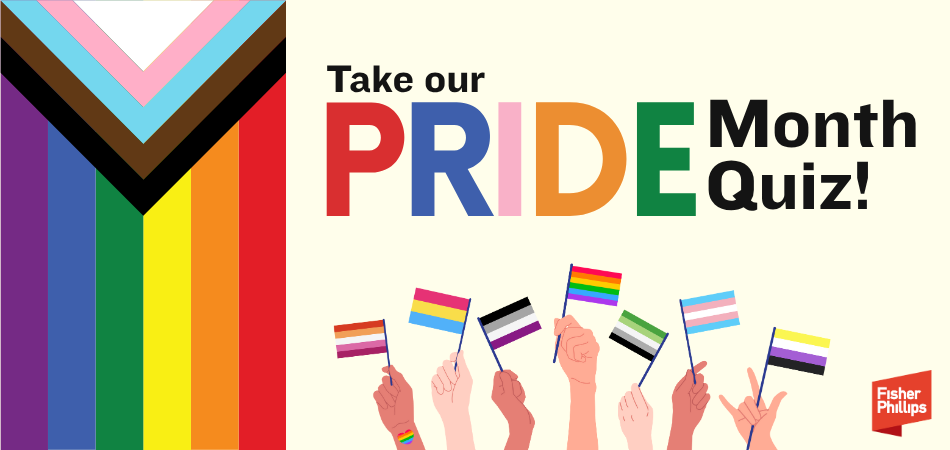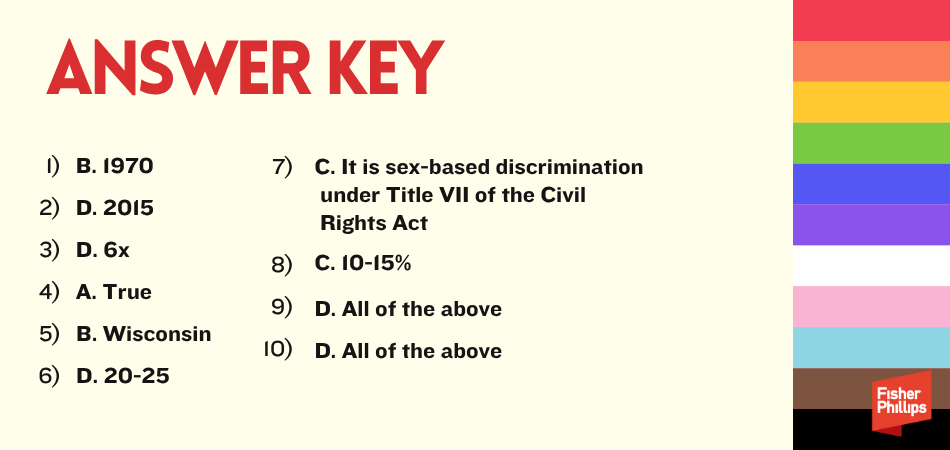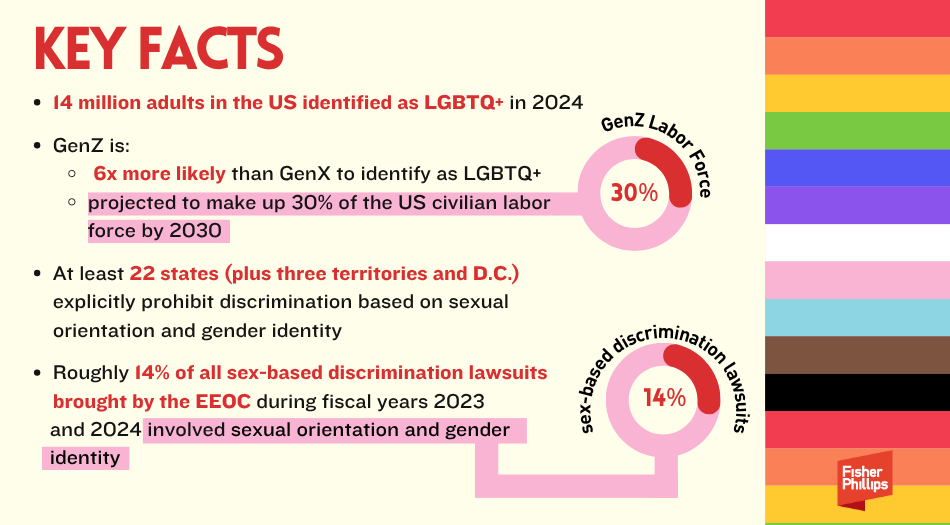FP Pop Quiz: How Much Do You Know About Pride Month and LGBTQ+ Rights in the Workplace?
Insights
6.11.25
Pride Month provides an opportunity for you to recognize the resilience of the LGBTQ+ community at your workplace amid an evolving and often challenging legal and political landscape. Now more than ever, this year’s Pride celebration comes at a critical time for you to support members of the LGBTQ+ community at your place of business while keeping up with the evolving challenges they face. We invite you to take this quiz and learn more about Pride history and LGBTQ+ rights in the workplace.
1. In what year did the first pride march take place?
a. 1965
b. 1970
c. 1973
d. 1992
2. In what year did the Supreme Court strike down state bans on same-sex marriages as unconstitutional?
a. 1995
b. 2004
c. 2013
d. 2015
3. Roughly 14 million adults in the US identified as LGBTQ+ in 2024, and that number is growing rapidly as members of Gen Z are _____ more likely than their Gen X counterparts to identify as LGBTQ+.
a. 2x
b. 3x
c. 4x
d. 6x
4. Federal law requires states to recognize same-sex marriages performed in other states.
a. True
b. False
5. Which was the first state to ban workplace discrimination based on sexual orientation?
a. New York
b. Wisconsin
c. California
d. Massachusetts
6. How many states have enacted laws explicitly prohibiting discrimination based on sexual orientation and gender identity?
a. 5-10
b. 10-15
c. 15-20
d. 20-25
7. In Bostock v. Clayton County (2020), the Supreme Court held that firing an individual merely for being gay or transgender is unlawful because:
a. It violates the Equal Protection Clause
b. It is sex-based discrimination under Title IX of the Civil Rights Act
c. It is sex-based discrimination under Title VII of the Civil Rights Act
d. It disparately impacts one sex or another under a theory of Title VII liability
8. During fiscal years 2023 and 2024, the EEOC filed a total of 102 sex-based discrimination “merits” lawsuits (including Title VII claims and claims under other federal antidiscrimination laws enforced by the EEOC). Approximately how many of those lawsuits involved sexual-orientation- or gender-identity-based discrimination?
a. 0% to 5%
b. 5% to 10%
c. 10% to 15%
d. 15% to 20%
9. In April 2024, the Equal Employment Opportunity Commission (EEOC) issued guidance stating that Title VII harassment includes:
a. Epithets regarding sexual orientation or gender identity
b. Repeated and intentional use of a name or pronoun inconsistent with the individual’s known gender identity
c. Denying access to a bathroom or other sex-segregated facility consistent with the individual’s gender identity
d. All of the above
10. Although a federal judge scrapped portions of the EEOC’s 2024 workplace harassment guidance in May 2025, the following remains true under the current legal and political landscapes:
-
- Sexual orientation remains a protected class under Title VII
- Gender identity remains a protected class under Title VII
- Sexual orientation and gender identity remain protected classes under various state and local laws
- All of the above are true
Scroll down to find the answer key…
Check Your Answers and Learn More
1. [b] The first pride march took place in June 1970 to commemorate the one-year anniversary of the Stonewall Riots, which ignited the gay rights movement in the United States and beyond.
2. [d] In Obergefell v. Hodges (2015), the Supreme Court held that same-sex couples have a constitutional right to marry. This landmark decision prohibits states from banning same-sex marriage and requires all states to recognize same-sex marriages lawfully formed in other states. Two years prior, SCOTUS struck down Section 3 of the federal Defense of Marriage Act (DOMA), which had essentially barred same-sex married couples from being recognized as spouses for purposes of federal laws, ruling that the DOMA provision violated the Fifth Amendment (United States v. Windsor).
3. [d] According to a 2024 report by EY, members of Gen Z (born between 1997 and 2012), are six times more likely than Generation X to identify as LGBTQ+. “Given that 30% of the US civilian labor force is projected to be Gen Z by the year 2030,” says the report, “it’s important for companies to be more intentional in their efforts to attract and engage the LGBTQ+ workforce as both an organizational culture and business imperative.”
4. [a] In response to concerns that Obergefell could potentially be overturned in the future, the Respect for Marriage Act was passed by Congress and signed into law by President Biden in 2022. The federal law ensures that all legally formed marriages, including same-sex and interracial marriages, will be recognized as such by the federal government and by all 50 states.
5. [b] In 1982, Wisconsin became the first US state to ban workplace discrimination on the basis of sexual orientation. Minnesota made history in 1993 when it became the first state to ban workplace discrimination based on sexual orientation and gender identity.
6. [d] At least 22 states (plus three territories and D.C.) explicitly prohibit discrimination based on sexual orientation and gender identity. An additional two states explicitly prohibit discrimination based on sexual orientation, but not gender identity. Learn more here.
7. [c] In Bostock v. Clayton County (2020), the Supreme Court held: “For an employer to discriminate against employees for being homosexual or transgender, the employer must intentionally discriminate against individual men and women in part because of sex. That has always been prohibited by Title VII’s plain terms.” Read more about the historic decision here.
8. [c] According to EEOC Annual Performance Reports for FY 2023 and FY 2024, the agency filed a total of 102 sex-based discrimination lawsuits under the various laws enforced by the agency (including, but not limited to, Title VII), during the two-year period beginning October 1, 2022, and ending September 30, 2024. Of those lawsuits, 10 involved sexual-orientation-based discrimination, and four lawsuits involved gender-identity-based discrimination.
9. [d] The Biden-era guidance provided broad protections for LGBTQ+ workers, especially against forms of gender identity discrimination, concluding that this was a natural extension of the groundbreaking Bostock decision. Here are the main takeaways.
10. [d] On May 15, a federal judge in Texas struck down portions of the EEOC’s 2024 workplace harassment guidance, including all parts requiring Title VII protections based on sexual orientation or gender identity – especially, bathroom, dress, or pronoun accommodation requirements. While Judge Matthew Kacsmaryk applied a narrow reading of Bostock to conclude that these portions of the agency’s guidance are contrary to Title VII (and while the Trump administration has taken similar positions in attempts to eliminate protections based on gender identity), this is an evolving area of the law, and another court could potentially interpret Bostock much more broadly. (Note: another challenge to the EEOC’s 2024 harassment guidance is pending in a federal court in Tennessee, and we may see this issue reach the Supreme Court, with the Justices revisiting the scope of Bostock.) Given the current state of confusion in this area, employers should work with counsel to prepare a Title VII compliance plan and to ensure continued compliance with applicable state and local antidiscrimination laws.
Conclusion
Contact your Fisher Phillips attorney or the authors of this Insight to create fair and legally compliant programs for all workers to succeed. We will continue to monitor developments and provide updates on this and other workplace issues, so make sure you are subscribed to Fisher Phillips’ Insight System to gather the most up-to-date information.
Related People
-
- Sheila M. Abron
- Partner
-
- Alexandra LaCombe
- Partner
-
- Frank F. Martinez
- Partner





